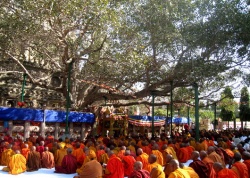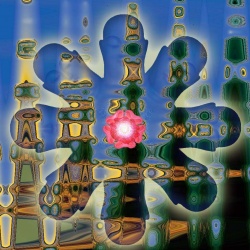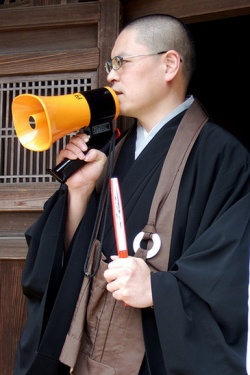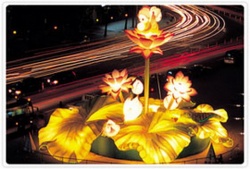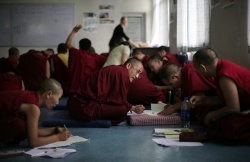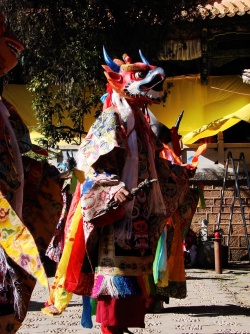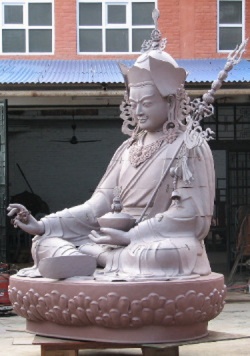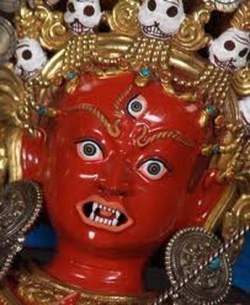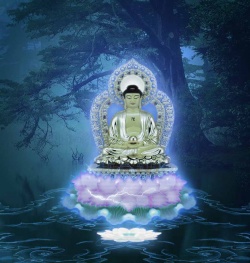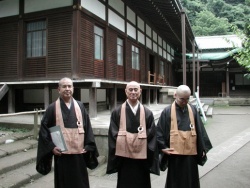Yoga Tantra: Paths to Magical Feats
Yoga Tantra
Paths to Magical Feats
His Holiness the Dalai Lama Dzong-ka-ba Jeffrey Hopkins
Translated and edited by Jeffrey Hopkins
Co-edited by Kevin A. Vose and Steven N. Weinberger
Appendix: Achieving Buddhahood through the Five Manifest Enlightenments by Lo-sang-66-gyi-gyel-tsen 154 Back-notes 159 List of Abbreviations 165 Bibliography 167 Index 175
1. The Basics
Yoga Tantra
The Root Tantra
2. Yoga With Signs
Coarse Yoga With Signs
A Student's Single Yoga 34Seal-Impression 38A Master's Great Yoga of Self-Completion 42Three Meditative Stabilizations 44 Meditation on a Subtle Object
Process of Achieving Calm Abiding 48Developing Meditative Dexterity in Yoga Tantra 3. Yoga Without Signs
Meditating on Emptiness
Progress on the Path
Purpose of Yogas With and Without Signs
4. Feats 64
11: The Great Exposition of Secret Mantra: Yoga Tantra by Dzong-ka-ba 67
1. The Root Tantra
I low the Stages of the Path Are Taught in Yoga Tantras
[The Parts of the Compendium of Principles Tantra] [The Four Sections as being Both for Separate Persons and for One Person] 71[Seventy-Two Meditative Stabilizations] 72[Four Sections, Lineages, Mandalas, Bases of Purification, Afflictive Emotions, Seals, and Effects of Purification] 73[Pattern of Deity Yoga]
2. Initiation and Vows
Stages of Practicing the Meaning of the Yoga Tantras
How to Become a Receptacle Suitable for Cultivating the Paths 78Having Become a Receptacle, How to Maintain Purity of Pledges and Vows 79 3. Observing a Deity 82
How to Perform Prior Approximation while Abiding in the Pledges 82Yoga With Signs 82Yoga of Four Sessions Observing the Coarse, a Deity 82Cultivation of the Yoga Observing the Coarse, a Deity, in Four Sessions 82Yoga of Four Sessions for Those Who Have Obtained Only a Student's Initiation
Yoga of Four Sessions for Those Who Have Obtained a Master's Initiation 86Procedure for Those Unable to Cultivate the Yoga Observing a Deity in Four Sessions
4. Observing a Hand-Symbol 91
Yoga of Four Sessions Observing the Subtle, a Hand-Symbol Purpose of Meditating on a Subtle Object 91Making the Mind Stable through Observing a Subtle Object 92How to Perform Diffusion, Gathering, and so forth Once Stability Is Attained
5. Yoga Without Signs
Yoga Without Signs 98How Yoga Without Signs Is Explained in the Compendium of Principles Tantra 98How Yoga Without Signs Is Described in an Explanatory Tantra How Yoga Without Signs Is Cultivated in the One-Gone-Thus Lineage How Yoga Without Signs Is Cultivated in the Vajra Lineage 101How Yoga Without Signs Is Cultivated in the Jewel Lineage 102How Yoga Without Signs Is Cultivated in the Lotus Lineage 103Brief Exposition of How to Cultivate Yoga Without Signs 6. Feats
How to Achieve Feats once the Approximation Is Serviceable 110How to Achieve Feats through Concentration 110Revealing Treasure 1 1 1Not Sinking into Water 112Going in Space 112Knowledge-Mantra Bearer 113Physical Transformation 113How to Achieve Feats through Repetition 115Physical Transformation 115Pledge Seal 115Protection 116Diagnosing Possession through Descent 116Finding Lost Articles through Descent 117Physical Displays through Descent 117Controlling Another's Mind 117Love and so forth 118How to Achieve Feats through Burnt Offerings 118 III: Supplement by Ke-drup-ge-lek-Gel-sang
1. Five Manifest Enlightenments
2. Four Seals 128
Etymology of Seal 128
Divisions of Seals 128
Order of the Four Seals 131
Purpose and Benefit of Seal-Impression 134
How to Do Seal-Impression 134
Pledge Seal 134Cause Giving Rise to a Pledge Seal 134Rite of Constructing the Entity of a Pledge Seal Itself 135Cause of Achieving a Pledge Seal 135Cause of Mastery over What Has Been Achieved 136Doctrine Seal 136Cause Giving Rise to a Doctrine Seal 136Rite of Constructing the Entity of a Doctrine Seal Itself &Cause of Achieving a Doctrine Seal 136Cause of Mastery over What Has Been Achieved 137Action Seal 138Cause Giving Rise to an Action Seal 138Rite of Constructing the Entity of an Action Seal Itself 138
Cause of Achieving an Action Seal 138Cause of Mastery over What Has Been Achieved 138Great Seal 139Cause Giving Rise to a Great Seal 139Rite of Constructing the Entity of a Great Seal Itself 139Cause of Achieving a Great Seal 139Cause of Mastery over What Has Been Achieved 139IV: Practical Outline of the Steps of the Path formulated by Jeffrey Hopkins 141 The Practice of Yoga Tantra 143
Yoga With Signs 143
Yoga Observing a Single Deity in Four Sessions for Those Who Have Obtained a Student's Initiation 143Yoga Observing a Complete Mandala of Deities in Four Sessions for Those Who Have Obtained a Master's Initiation 148Great Yoga of Self-Completion 148Three Meditative Stabilizations 149Procedure for Those Unable to Cultivate either the Yoga Observing a Single Deity or the Yoga Observing a Mandala of Deities 150Yoga Observing a Subtle Hand-Symbol in Four Sessions 150 Yoga Without Signs 152
Appendix: Achieving Buddhahood through the Five Manifest Enlightenments by Lo-sang-cho-gyi-gyel-tsen 154Backnotes 159List of Abbreviations 165Bibliography 1671. Sutras and Tantras 1672. Other Sanskrit and Tibetan Works 168Index 175
Sets of Fours 32Seventy-two Meditative Stabilizations
demonstrated by Jhado Tulku, abbot emeritus of Namgyel Tantric College (see insert)Seal
1. great seal of VajrasattvaSeal
2. pledge seal of VajrasattvaSeal
3. doctrine seal of Vajrasattva for yoga without signsSeal
4. action seal of VajrasattvaSeal
5. vajra-bindingSeal
6. vajra-palmsSeal
7. vajraSeal
8. iron hook
Preface
by Jeffrey I lopkins
This book on Yoga Tantra is the third in a series presenting The Stages of the Path to a Conqueror and Pervasive Master, a Great Vajradhara: Revealing All Secret Topics' by the late-fourteenth- and early-fifteenth-century scholar and yogi Dzong-ka-ba Lo-sang-drak-ba" of Tibet. By way of introducing the present book, let us briefly consider Dzong-ka-ba's procedure in the first two volumes.
1. TANTRA IN TIBET Dzong-ka-ba's text begins the Great Exposition of Secret Mantra,' as it is also called, with an examination of the difference between the Buddhist vehicles. That section-presented in the first book in this series, Tantra in Tibet'mainly analyzes a variety of earlier delineations of the difference between the Sutra Great Vehicle and the Mantra Great Vehicle. Although he does not mention Bu-don Rin-then-drupd (1290-1364) by name, it is apparent that his prime source is Bu-don's encyclopedic presentation of the difference between Sutra and Mantra in his Extensive General Presentation of the Tantra Sets, Key Opening the Door to the Precious Treasury of Tantra Sets.` Budon lists presentations by several Indian scholars who delineate various numbers of ways the Mantra Great Vehicle surpasses the Sutra Great Vehicle, or Perfection Vehicle as it is commonly called:
• Tripitakamala and commentator Vajrapani-four differences
• Jnanashri-eleven differences
• Ratnakarashanti-three differences
• Nagarjuna-six differences'
• Indrabhuti-seven differences
• Jnanapada-three differences
• Dombhi heruka-five differences
Vajraghantapada-four differences
• Samayavajra-five differences.
In a radical departure from Bu-don's catalogue of opinions, Ijzong-ka-ba analyzes the structure of the path to Buddhahood and analytically chooses to emphasize a single central distinctive feature of the Mantra Vehicle, deity yoga. The main points he makes in distinguishing the Lesser Vehicle and the Great Vehicle and, within the latter, the Sutra and Mantra forms, are:
• The difference between vehicles must lie in the sense of "vehicle" as that to which one progresses or as that by which one progresses.
• The Lesser Vehicle differs from the Great Vehicle in both. The destination of the lower one is the state of a Hearer or Solitary Realizer Foe Destroyer and of the higher one, Buddhahood.
• Concerning "vehicle" in the sense of means by which one progresses, although there is no difference in the wisdom realizing emptiness, there is a difference in method-Lesser Vehicle not having and Great Vehicle having the altruistic intention to become enlightened and its attendant deeds.
• Sutra and Mantra Great Vehicle do not differ in terms of the goal, the state being sought, since both seek the highest enlightenment of a Buddha, but there is a difference in the means of progress, again not in wisdom but in method.
• Within method, Sutra and Mantra Great Vehicle differ not in the basis or motivation, the altruistic intention to become enlightened, nor in having the perfections as deeds, but in the additional technique of deity yoga. A deity is a supramundane being who himself or herself is a manifestation of compassion and wisdom. Thus, in the special practice of deity yoga one joins one's own body, speech, mind, and activities with the exalted body, speech, mind, and activities of a supramundane being, manifesting on the path a similitude of the state of the effect.
As scriptural authority for the central distinguishing feature between the Sutra and Mantra Great Vehicles, Uzong-ka-ba quotes a passage from the Vajrapanjara Tantra,' rejects the commentaries of Krshnapada and Indra- bodhi," and critically uses the commentary of Devakulamahamati,' accepting some parts and rejecting others. He reinforces his presentation of deity yoga as the dividing line between the two Great Vehicles with citations from or references to works on Highest Yoga Tantra by Jnanapada,' Rat- nakarashanti,' Abhayakara,' Durjayachandra," Shridhara,' Samayavajra," Ji-nadatta," and Vinayadatta."
Despite Thong-ka-ba's many citations of tantras and Indian commentaries, it is clear that they are used only as supportive evidence for his argument. Tradition is only supportive, not the ultimate authority. The arbiter is reason, specifically in the sense of determining coherence and consistency within a path structure. Thong-ka-ba refutes Ratnarakshita and Tripitakamala, " for instance, not because they differ from the aforementioned sources but because their presentations fail in terms of consistency with the path structure. By doing so, he moves the basis of the presentation from scriptural citation to reasoned analysis of a meditative structure.
Also, whereas Bu-don catalogues nine ways that Indian scholar-yogis differentiate the four tantra sets-by way of the four Indian castes, four schools of tenets, four faces of Kdachakra, four periods of the day, four eras, followers of four deities, four afflictive emotions to be abandoned, four levels of desire to be purified, and four levels of faculties-I)zong-ka-ba critically examines most of these, accepting only the last two, with modification. I le differentiates the four Tantra sets by way of their main trainees being of four very different types, since these trainees have (1) four different ways of using desire for the attributes of the Desire Realm in the path and (2) four different levels of capacity for generating the emptiness and deity yogas that use desire in the path.
In his systemization, the four tantras are not differentiated (1) by way of their object of intent since all four are aimed at bringing about others' welfare, or (2) by way of the object of attainment they are seeking since all four seek the full enlightenment of Buddhahood, or (3) by way of merely having different types of deity yoga since all four tantra sets have many different types of deity yoga but are each only one tantra set. Rather, the distinctive tantric practice of deity yoga, motivated by great compassion and beginning with emptiness yoga, is carried out in different ways in the four tantra sets. Various levels of desire-involved in gazing, smiling, touching, and sexual union-are utilized by the respective main trainees in accordance with their disposition toward styles of practice, these being to emphasize external activities, to balance external activities and meditative stabilization, to emphasize meditative stabilization, or to exclusively focus on meditative stabilization.
Dzong-ka-ba's exposition represents an appeal to analysis, a carefully constructed argument based on scriptural sources and reasoning, with the emphasis on the latter. Consistency, coherence, and elegance of system are the cornerstones; his procedure is that of a thorough scholar, analyzing sources and counter-opinions with careful scrutiny and determining the place of the pillars of his analysis in the general structure of a system. His intention is clearly not to present a catalogue of views as Bu-don mainly does, but to adjudicate conflicting systems of interpretation, thereby establishing a radically new one.
2. DEITY YOGA The second and third sections of the Great Exposition of Secret Mantra, concerned with Action Tantra and Performance Tantra, are presented in the second book in this series, Deity Yoga." At the start of his exposition of Action Tantra, Dzong-ka-ba critically examines an issue that Bu-don left hanging: Does Action Tantra have imagination of oneself as a deity or only imagination of a deity in front of oneself? Bu-don" catalogues conflicting opinions on the topic, and after presenting a detailed case against reasons behind Buddhaguhya's and Varabodhi's assertion that Action Tantras involve imagination of oneself as a deity, leaves the issue with advice to analyze which side is right. However, in explaining the path procedure of Action Tantra," Bu-don presents the system of those who say it has deity yoga. The apparent self-contradiction is explained by the encyclopedic nature of his work, built on an intention to include as many systems and viewpoints as possible.
